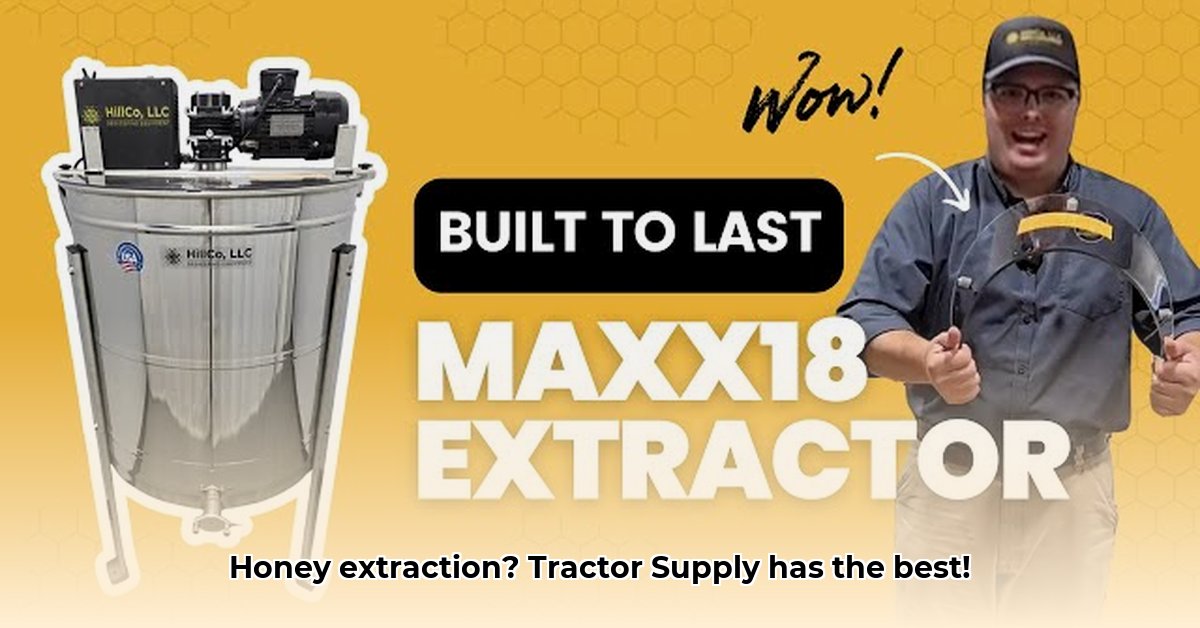
Honey Extractor Tractor Supply: Your Guide to Sweet Success
Harvesting your own honey is incredibly rewarding, but choosing the right honey extractor can be challenging. This guide focuses on finding the perfect manual honey extractor, particularly at Tractor Supply. We'll cover essential factors, different extractor types, and maintenance tips to ensure a smooth and successful honey harvest. For more on Tractor Supply equipment, check out this helpful resource: Tractor Supply Equipment.
Choosing the Right Honey Extractor: Key Considerations
Selecting the best honey extractor involves several key decisions impacting efficiency and longevity. Let's explore the crucial factors:
Size and Capacity: Matching Your Beekeeping Operation
The size of your honey extraction operation dictates the required extractor capacity. A two-frame extractor suits hobbyists with a few hives, processing smaller batches efficiently. Larger operations, however, benefit significantly from eight-frame or larger extractors, saving considerable time and effort.
- Consider this: How much honey do you anticipate harvesting annually? While a larger extractor might seem excessive initially, it can prove invaluable if your operation expands.
Material Selection: Stainless Steel vs. Plastic
The extractor's material significantly impacts durability and maintenance. Stainless steel extractors are the industry standard due to their exceptional durability, easy cleaning, and longevity. While pricier, the investment pays off in the long run, minimizing replacements. Plastic extractors offer a budget-friendly alternative, but they might require more frequent replacements due to reduced robustness.
- Did you know? Stainless steel's smooth surfaces prevent honey buildup, simplifying cleaning and maintaining hygiene.
Ease of Use and User Reviews: Practicality and Feedback
Look for an intuitive and easy-to-operate extractor. Features like easy-to-turn handles or quick-release mechanisms can significantly simplify the process. Crucially, consult online reviews from fellow beekeepers. These authentic experiences offer invaluable insights into the strengths and weaknesses of various models. Focus on comments regarding durability, ease of cleaning, and any encountered issues.
Honey Extractor Types at Tractor Supply: A Comparison
Tractor Supply typically stocks manual honey extractors, mainly two-frame and larger capacity models. This table offers a direct comparison:
| Feature | Two-Frame Extractor | Eight-Frame Extractor | Larger Capacity Extractors (12-frame etc.) |
|---|---|---|---|
| Capacity | Small-scale honey production | Larger honey harvests | High-volume honey production |
| Cost | Generally more affordable | More expensive | Most expensive |
| Ease of Use | Simple operation | Can require more effort | May demand more strength and experience |
| Maintenance | Easy cleaning and maintenance | More thorough cleaning required | Thorough cleaning and potentially specialized tools |
| Space Requirements | Compact storage | Requires more storage space | Requires significant storage space |
Important Note: Tractor Supply's stock varies by location and season. Always verify availability at your local store.
Finding Your Perfect Extractor: Beyond the Store
While online research is valuable, visiting your local Tractor Supply is highly recommended. Directly examining the extractors allows you to assess their size, weight, and features firsthand. Don't hesitate to consult store staff; their insights based on local beekeeper preferences can be invaluable. Combine in-store exploration with online reviews for a comprehensive perspective.
Maintenance and Safety: Ensuring Longevity and Safe Operation
Proper maintenance extends your extractor's lifespan and ensures safe operation. Follow these steps for effective cleaning:
- Immediate Post-Use Cleaning: Remove all honey residue promptly for easier cleaning.
- Thorough Rinse: Use warm water and mild detergent; a soft brush helps remove stubborn honey.
- Complete Drying: Ensure thorough drying before storage to prevent rust or mold.
- Regular Inspection: Check for any damage, loose parts, or wear.
Prioritize safety: Always wear protective gear (gloves) when handling the extractor and honey. Exercise caution when handling sharp parts and ensure stability before operation.
Your Path to Sweet Success: Making the Informed Choice
Choosing a honey extractor is a significant investment with long-term rewards. By considering your needs, budget, and the scale of your beekeeping operation, you can make an informed selection that optimizes your honey harvesting process. There’s no one-size-fits-all solution; the ideal extractor depends entirely on your specific context. Happy harvesting!